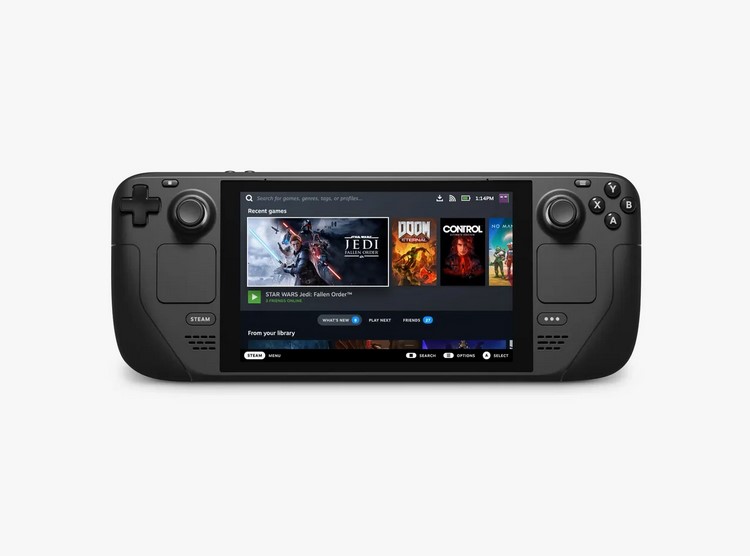
The handheld PC market has been evolving and evolving, the GPD Win family has been getting better and better and we now have newcomers like the Aya Neo and even Alienware entering the fray. Now, Valve wants a slice of the pie and they seem to be making a fundamentally solid attempt at it and should have the best build quality by miles.
We’ll only know for sure once the Steam Deck is out, but on paper here’s a comparison with the Aya Neo, which is also an AMD APU-based device.
Let’s talk PO-PO-POWERRRRRRR…!!!
The Specs
Steam Deck
Custom AMD APU
CPU: Zen 2 4c/8t, 2.4-3.5GHz (up to 448 GFlops FP32)
GPU: 8 RDNA 2 CUs, 1.0-1.6GHz (up to 1.6 TFlops FP32)
RAM: 16 GB LPDDR5 RAM (5500 MT/s). Just to clarify MT/s is the same as MHz
Screen: Optically bonded LCD for enhanced readability
OS: SteamOS 3.0 (Arch-based)
Aya Neo
CPU: Ryzen 4500U 6 Cores
GPU: AMD Radeon Vega 6 @ 1.5 GHz
RAM: 16GB LPDDR4 4266 MHz
Screen: H-IPS pane
OS: Windows 10
Now, before I get into some details that may well be missed with a cursory glance, from what I’ve seen the Aya Neo can run things like Horizon Zero Dawn on low at 800p and around 20-35 fps on low, with the CPU being the bottleneck. I’ve also seen RDR2 run at around 37fps average at 720p (90% of native res) on low with 80% or so CPU usage and 15 watts TDP. I also saw it run DOOM Eternal on high at 720p at a near-locked 60. All this serves to give a ballpark idea of its performance.
Let’s now dissect the specs, without having one in hand, however, it’s hard to be sure but on paper at least it’s a BEAST. To start with, the CPU on the Steam deck has 2 fewer cores than the Aya Neo, which seems like a red flag. However, the thing to remember here is when I was watching the RDR2 Aya footage, the CPU was running at 1.4GHz and GPU at 1.2-1.58GHz. Whereas the Steam deck CPU is running at 2.4-3.5GHz and also has 2 more threads due to SMT, although in the grand scheme that usually won’t make up for having fewer cores.
However, the clock speed is the key differentiator here. In the worst-case scenario, the CPU is just slightly under 1.75x the clock speed, at best it’s 2.5x the clock speed. Now, it is true that you can use custom profiles on the Aya to ramp up the CPU speed, however, while it can cope with cooling, it’ll be putting out more heat and more battery drain than what the Aya was designed for. Now, some games will benefit from cores more than speed, but other games will be more about CPU speed than cores, however, even in a core advantage scenario having 1.75x the clock speed should help significantly reduce that disparity, if not eliminate it entirely.
On the GPU side, the Steam Deck has a HUGE ADVANTAGE and I’m curious if the CPU might bottleneck, but I would imagine that Valve designed this as best they can. The GPU uses RDNA 2 Architecture with 8 CUs running at 1.0GHz to 1.6GHz. There is no practical way to really compare the GPUs as they have a different architecture altogether, however, what we do know is that the top end is slightly faster and RDNA 2 is vastly superior to Vega 6 in every single way. I believe the Vega 6 in the Aya uses the old GCN units vs RDNA 2 and its CUs of the Steam Deck, RDNA 2 is rated to have up to 65% more performance per watt over the old RDNA architecture, which was 50% more performance per watt over GCN in traditional GPUs. So, in theory, we could be seeing nearly DOUBLE the GPU performance in the Steam deck. Factor in the fact that the CPU is 1.75x to 2.5x faster, that’s a whole lot more power than the Aya could ever dream of.
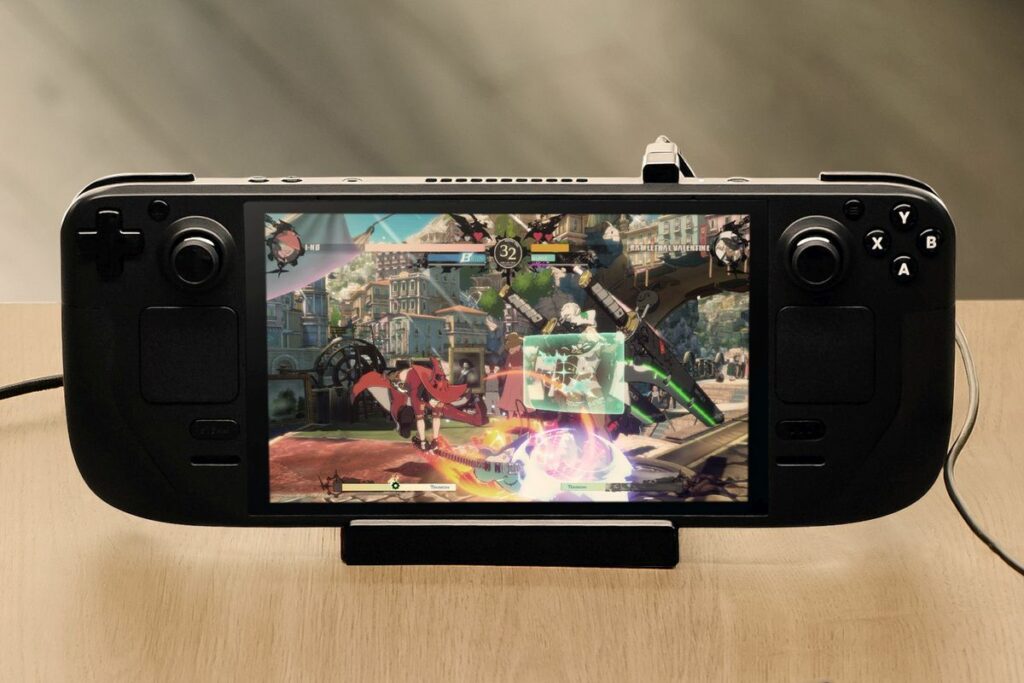
Then we have memory which is almost 30% faster. RAM speed is something often overlooked in PCs, it’s true the higher you go, the smaller the gains you get and you hit a wall where the returns are not worth the cost. However, faster RAM can improve minimum fps by 10% or so, depending on the game. The other thing to remember here is that this is an APU, meaning the GPU and CPU is using the same RAM pool, effectively fighting for bandwidth, so an extra 30% here could end up being highly significant. This is likely one of the reasons the CPU is clocked higher; there is much more bandwidth to go around in the Steam Deck which, if that was the only difference it had with the Aya, would still make it perform significantly better.
In addition to all this, the Steam deck is running the Steam OS which will have a lot less resource overhead than Windows, plus has been specifically designed to fully utilize the Steam Deck as effective as possible, remarkably similar to consoles and one of the reasons why they can hit above their spec in a 1:1 comparison with PC.
So, to summarise, the Steam Deck has a significantly faster CPU, GPU, and RAM, in addition to much less resource overhead due to its OS, meaning even more performance gains. The Steam Deck is by miles the strongest handheld console – it is the Terry Crews of handhelds. Then there’s the emulation angle. Given that the Aya Neo can 4K Gamecube games and anything before the Gamecube, the Steam Deck is going to be a beast in that area. Then you factor in that the Aya Neo tends to fall slightly short on Switch emulation, the extra GPU and CPU power here could see Switch games running at native res and if not better performance. Then there’s your entire Steam library and cloud saves…and it makes it an interesting proposition indeed.
Display
The one thing the Steam deck could lose out on here is the display. It seems to use a standard LCD and could well be TFT as the panel tech is not stated. This will mean that colours will be far less accurate than the Aya Neo, however, the latency could be lower due to that, meaning a cleaner image in motion. I would like to know more about its screen; it’s optically bounded which should improve visibility in the outdoors, has an ambient light sensor, and the top-end model has anti-glare etched glass. So, the weak point here in comparison to the Aya could well be the display, but I imagine that it’s going to be a pros and cons trade-off.
Ergonomics/Design and Controls
The controls look super awkward, but the video below provided by IGN states it’s much more comfortable than it looks. It’s impossible that they wouldn’t have tested the ergonomics of this and the very curved nature of the Steam Deck should make it feel quite comfortable. It has some genuinely nice input options, weighs 669 grams which may feel quite heavy as it’s just over twice the weight of the Switch, but only ways 19 grams more than the Aya Neo, so it’s within expectations. Its size, however, is quite large at 298mm x 117mm x 49mm. In comparison, the Nintendo Switch is 239mm x 102mm x 28.7 mm and the AYA is 255mm x 106mm x 20mm.
Gamepad controls: A B X Y buttons, D-pad, L & R analog triggers, L & R bumpers, View & Menu buttons, 4 x assignable grip buttons.
Thumbsticks: 2 x full-size analog sticks with capacitive touch.
Haptics: HD haptics.
Trackpads: 2 x 32.5mm square trackpads with haptic feedback, 55% better latency compared to Steam Controller with pressure sensitivity for configurable click strength.
Gyro: 6-Axis IMU.
microSD: UHS-I supports SD, SDXC, and SDHC
External connectivity: controllers & displays USB-C with DisplayPort 1.4 Alt-mode support; up to 8K @60Hz or 4K @120Hz, USB 3.2 Gen 2.
I particularly like the assignable grip buttons. I also love how it looks visually and it reminds me heavily of the Sega Game Gear. A dock is being made for it to be sold at a yet-to-be-announced date, but it has been stated any USB-C dock will work.
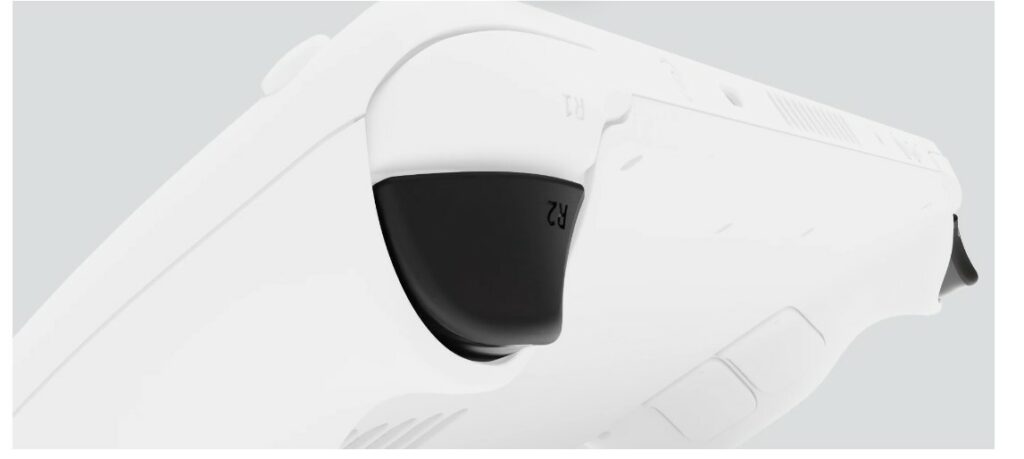
The rest of the specs are in the pictures below. The DSP will be interesting to listen to, as the quality of the index HMD audio is absolutely fantastic, so I’m very eager to hear what the onboard audio sounds like on my earphones, headphones, and the Steam Deck’s speakers. If I had to nitpick, the lack of WIFI 6 is disappointing although expected.
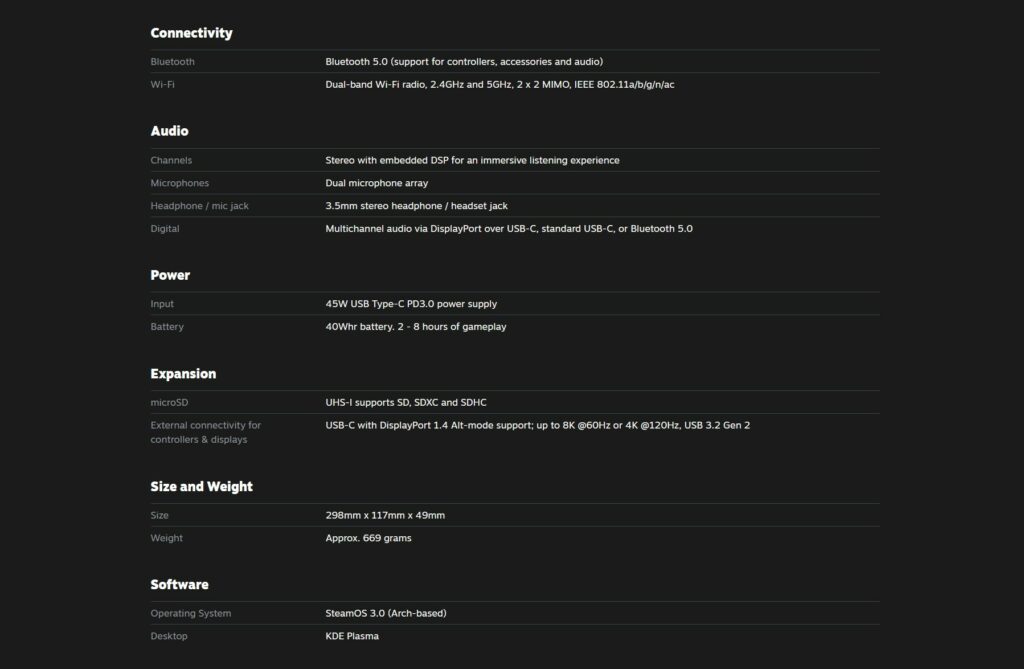
Battery
The battery is rated at 2-8 hours, but Valve has said Portal 2 at 60fps will last about 4 hours. While this may seem underwhelming to some, this is what I would expect of a device of this size with so much power crammed into it. Also, when you think of games like BOTW lasting about 3 hours on Switch at 30fps, and the Switch battery in general, it’s quite good.
Pricing
This is where I’m blown away. The Aya Neo will RRP at around £600 GBP without a case, whereas all Steam decks come with a case. Meanwhile, the Steam Deck Premium model, with the premium anti-glare etched class along with some digital extras, is priced at £569 in the UK, making it cheaper while being significantly better and it comes with a case. The 64GB eMMC model is £349, and the 256GB NVME SSD version is £459. The eMMC version should be avoided in my opinion, because eMMC memory is garbage and will likely not last as long as the NVMEs while being significantly slower. Although an SD card is an option to try and overcome the lack of storage, it’s still far from ideal, especially given the extra cost. The SD card will be slower than the eMMC and use more power, so the 256GB and higher seem like the best choices.
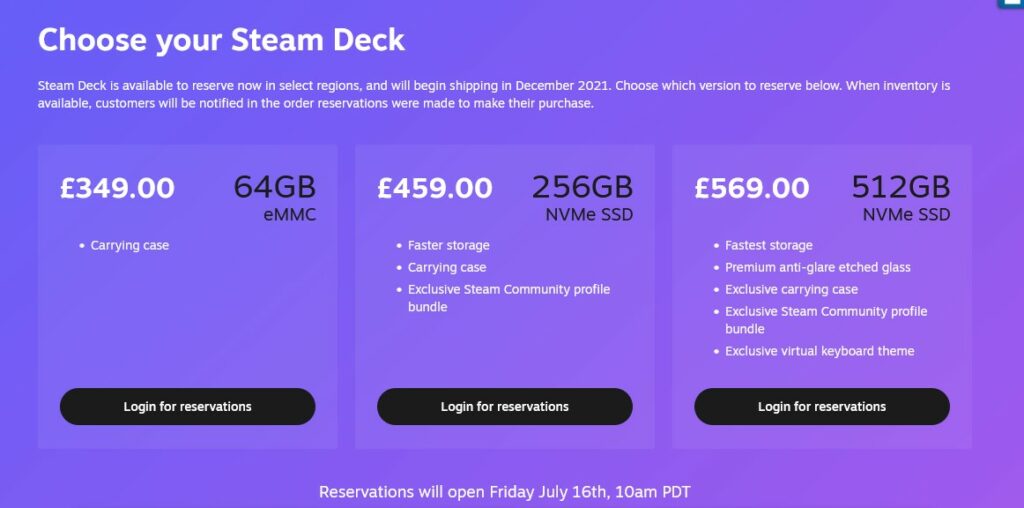
Conclusion
So, is the Steam Deck any good? Obviously, I need to try one out, but on paper, it’s miles ahead of any handheld PC and the Switch. It’s completely unmatched and I can see it running new fairly-demanding games on low to medium res at a locked 30 or 60 fps no problem, maybe even more, time will tell. Handheld PC gaming is a niche but growing market. I personally don’t need it, but definitely want one, as it’s a beast of a portable previous-gen console emulation machine and an incredibly strong handheld PC. With Steam games on the go and Switch emulation performance looking bright on paper, this may well be the handheld device I and many others have been waiting for.
If you already have a GPD device or an Aya, this is a significant upgrade and a no-brainer. Valve has come out of nowhere and set an incredibly high bar. The Reservations start tomorrow, the 16th of July, at 10 am PDT. Naturally, with the chip shortage, demand will outstrip supply so if you want a Steam Deck you’ll have to get in early. Just like with the Valve Index.